Old ice boxes hold great value in the present world. They may not be used for food storage purposes. But, they make fabulous antiques that you can display in your home.
They look elegant, elite, and exquisite.
It’s why antique collectors strike amazing offers to get their hands on the oldest ice boxes possible.
So, if you own an antique ice box, it’s best to find out the exact age. Remember; the older it is, the more valuable it will be.
In today’s post, we’ll teach you how to date an antique ice box using 8-effective methods. We’ll also discuss the types, brands, and values. Let’s dive in!
Table of Contents
What is an Antique Ice Box?
The antique ice box is a traditional-style refrigerator used in the early 1800s and 1900s. It was a common kitchen appliance that did not rely on any electricity or advanced mechanism. Instead, it only had a dedicated space for ice.
So, when people kept food inside, they also kept insulated chunks of ice with it. As a result, the coldness ensured that the food didn’t become soft and moldy. There was also a bottom compartment or catch pan to collect the melted ice water.
Back in those days, people referred to the ice box as either a refrigerator or a cold closet. It was after the invention of the electric refrigerator that people started using the term ice box only.
Please note there’s a difference between an antique and a vintage ice box. All the ice boxes that are 100 years old or above are considered true antiques. Meanwhile, ice boxes from the 1950s or later are called vintage.
How Does an Ice Box Work?
Watch this video to learn how an ice box works!
Types of Antique Ice Box
In the earliest times, the ice box was merely a need. It came with a simple and compact wooden structure. As time passed by, these ice boxes turned into essential décor too.
Craftsmen started making ice boxes with beautiful carvings and designs. The price of the ice box depended on how big and good-looking it was. However, since these weren’t durable, people soon started creating steel ice boxes.
These metallic structures were compact, efficient, and highly durable. Although the designs were scarce and prices were high, many people switched to these ice boxes. Poor folks kept their wooden ice boxes until the arrival of electric refrigerators.
Considering this history, we can see that there have been only two types of antique ice boxes so far. Let’s compare them in detail below!
Wooden Ice Box
A typical 19th-century old-fashioned ice box has a dresser-like structure. It has two main styles; narrow and tall or wide and short. In both cases, the ice box has several compartments.
The usual number is 4. However, rare finds are smaller with 2-compartments only. These were used by people who had very little storage requirements or couldn’t afford bigger versions.
Moreover, the antique wooden box doesn’t have a complete wood design. Wood only forms the outer protective shell. Inside, you’ll find an insulation system made from different materials.
The hollow walls are typically lined with zinc or tin. They’re also filled with insulating materials like:
- Seaweed
- Cork
- Flax straw fiber
- Sawdust
- Mineral wood
- Charcoal
Different wooden ice boxes have different looks too. It mostly depends on the type of wood. For example, an antique oak ice box has vibrant orangish hues, whereas a walnut ice box has dark brown shades.
That said, the oldest wooden ice boxes will have the simplest designs. There will be no carving or embellishment.
Steel Ice Box
The antique metal ice box came around the late 19th century. People were experiencing industrialization, and things were becoming contemporary. So, generally, it had a clean white enameled surface that reflected the changing trends of the time.
But, the styles were different. There were single compartment versions and multi-drawer ones. Even the drawers were installed in unique patterns (stacked on top of each other, adjusted sideways, etc.).
Since these ice boxes had a complete steel structure, they provided excellent insulation. They also had an increased lifespan.
Unlike the wooden ones, the metallic ice boxes did not deteriorate because of the melted ice water. There were no rotting or termite infestations. People were able to leave the collected water for longer periods without worries.
Ironically, most of the surviving antique ice boxes are wooden. These were either not heavily used or maintained regularly. However, even the few metallic ice boxes that you’ll find today are badly rusted.
How to Date an Antique Ice Box? 6 Easy Ways
Dating an antique ice box is no different than looking for a needle in a haystack. With so little information accessible, many people can’t figure out how to determine the age of their old ice box. Well, worry not because we’ve found the perfect solutions.
Here are the 6-easiest ways to date an antique ice box!
1. Look at the Manufacturer’s Label
Labels, nameplates, and tags are some of the best methods to date an ice box. Inspect the antique carefully and look for any kind of manufacturer marking. It can tell you the company name, patent year, symbols, or even a combination of letters.
These will be typically engraved on the front or back. In any case, the slightest information from the antique is a good clue to start your research for dating. For example, if you find a nameplate saying McCray, you will easily know the ice box is from the late 19th century.
How do we know this? It’s because the McCray company didn’t start producing ice boxes until the 1880s.
You can also examine the metallic hinges and joints. Since they were designed into different shapes, manufacturers often stamped names, production dates, or some other important data on them. You may also want to get your hands on any original paperwork that the owner might have.
2. Find the Distortions & Decay
It doesn’t matter whether you’re dealing with a wooden or a metallic ice box. The low-quality structure will give away its estimated age. How?
Well, the earliest ice boxes were made in a time when people didn’t have much skill or resources. Creating fine and perfect ice boxes was simply not possible. So, the number of distortions in an ice box is a good indicator of its age.
Ideally, look at the corners and finishing of the ice box. While craftsmen were able to make a decently precise structure, getting these two details was the hardest.
Decay is another good way to detect how old the ice box is. You should find visible scratches, cracks, and chips throughout the structure. There should be plenty of usage marks left by previous users too.
However, in case you come across an antique that was well-maintained by the owner, then pay close attention to the interiors. Its insulation system should have little to no applicability. The metallic linings must have rust and corrosion to great extent by now.
In wooden ice boxes, the drainage slots inside will have overly dark stains too.
3. Analyze the Hardware
The hardware of an ice box has valuable information concealed within its frame and design. Over time, people have used different hardware to manufacture things. Here are some types found in old ice boxes.
- Hinges
A hinge is a joint that connects the door/cabinets with the main structure. It allows them to swing open or close easily.
In the earliest ice boxes, the hinge was made out of leather or rubber gaskets. One single piece was attached to the front of the compartment doors. Later, by the mid-19th century, the hinges were metallic.
- Fasteners
Fasteners are also a type of joint that fix two pieces together. However, they do not allow any movement and are non-permanent. You can easily remove them without damaging the structure.
Antique ice boxes typically used nails and screws as fasteners. So, looking at the type of nails and screws hints at which era the ice box belongs to. For example, wire twist-like nails were used the most during the 1920s and 1930s.
4. Examine the Material
As discussed earlier, the types of ice boxes were made in a particular time period. The wooden ice boxes were the only option throughout the 1800s. Meanwhile, steel ice boxes became mainstream in the late 19th century and continued to be the top choice until the modern fridge was invented.
That said, if you find an antique ice box with a mix of materials or new ones like polymer, consider it a reproduction.
The original ice boxes weren’t made from any other material other than wood. You can find types of woods like oak, pine, and walnut. But, you won’t come across steel, iron, plastic, or anything else used in the exterior.
5. Go for the Simplest Designs
Everything is simple and plain at first. It’s because people are focusing more on making it work than looking beautiful. So, a great way to date an antique ice box is to evaluate the design.
An ice box without carved wooden spirals and patterns will be older than its counterpart. The same goes for the metallic ones. If you find a steel ice box with prints and painted designs, know that it is either vintage or contemporary.
Also, look at the overall structural design of the ice box. Sliding drawers, shelves, and multiple compartments were introduced later onwards. At first, wooden ice boxes only had 2 to 4 compartments with doors.
6. Visit an Antique Professional
All the methods described above are excellent for finding the estimated date of an antique ice box. But, if you want to determine the accurate date, visit an antique professional.
The professional can be a reputable collector, appraiser, show host, or anyone with sound knowledge about antique ice boxes. Contact the person and ask whether they can date your antique. Some may charge for the service.
In case you’re unable to get the attention of an expert, visit antique shows and events. There are a lot of valuable insights that you can collect on your way. You may also want to read the following print resources:
- American Ice Boxes: A Book on the History, Collecting and Restoration of Ice Boxes
- How to… Date an Antique Table: A Lover’s Guide
Antique Ice Box Brands
Although ice boxes have been in use for a very long time, it was Thomas Moore who first invented a proper unit for personal use. He called it a refrigerator and patented the box in 1803.
Since then, many companies have participated in the ice box manufacturing industry. Here are the most popular names:
D. Eddy & Son of Boston
- Eddy & Son of Boston was a wholesale manufacturing company founded in 1847. Their wooden ice box designs were plain, small, and functional. Plus, they sold the ice boxes at the lowest rates possible.
Later, they improved the design and built large ice boxes with a top loading section. You could put the huge ice box from the top and store the food items in the bottom cabinets with shelves.
Image
If you find a D.Eddy & Son of Boston ice box, know that it is from the oldest antique ice box manufacturers. Their company name is usually engraved on the ice storage compartment door.
Read more about D. Eddy & Son of Boston ice boxes in this original brochure!
Bending Hall Refrigerators
The Bending Hall Ice Box Company traces its roots back to 1877.
At the time, Belding in Michigan was very popular for its craftsmanship and hardwood resources. So, when Joshua moved into the area, the industry soon caught his attention, and he founded the company.
The Bending Hall made the standard wooden ice boxes with cabinets for residential use. Here’s an example from the early 1900s:
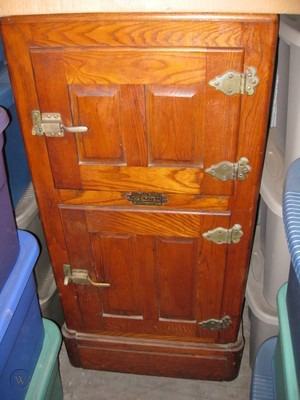
It has a beautiful oak wood exterior with two spacious compartments. All doors had spring lever latches for easy usage. Later, the company merged with another ice box manufacturer to create big commercial use refrigerators.
McCray Refrigeration Company
McCray was founded by the duo of son (Elmer E. McCray) and father (Hiram). The father was a merchant who sold butter and eggs. During summers, he faced great difficulty in trading goods.
It is when the duo invented a cold storage room and got a patent in 1882. Elmer McCray continued to work on creating improved refrigerator units while his father did most of the trading. By 1891, Elmer’s ice boxes were in good demand.
People bought them for both industrial and residential uses. Soon, he shifted the business to refrigerator production only and built a factory in Kendallville. Their ice boxes were marketed to have odorless wood for sanitary refrigeration.
The McCray wooden ice boxes were also a bit fancy. They had a lining of porcelain lined tiles and opal glasses. A McCray nameplate was present on all the units.
In 1975, the McCray refrigeration company merged with Howard refrigeration company (Philadelphia). The name was changed to Howard McCray.
The Baldwin Refrigerator Company
Located in Burlington, the Baldwin Refrigerator Company was formed in 1889. Its main focus was to produce high-quality wooden refrigerators for families and businesses. However, the company did not survive long and was closed around the 1930s.
You can still find some surviving wooden ice boxes like this one below.
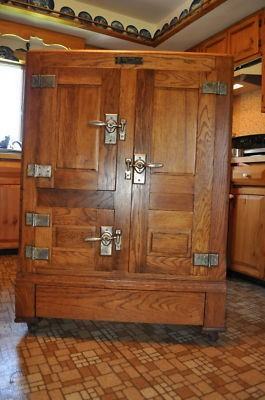
Ranney Refrigerator Company
The Ranney Refrigerator Company is another pioneer that started its journey in 1892. Its Michigan-based facility was known to be the best manufacturing plant in the country. As a result, the business had an overwhelming national demand.
Initially, Ranney produced fine wooden ice boxes for residential and personal use. Soon, it started experimentation and introduced ice boxes with a water cooling design. They had the same wooden exterior but steel interiors.
You can identify them by broad cubical structures that stand on four curved wooden legs. The ice box typically featured three compartments. Here’s an image of it:
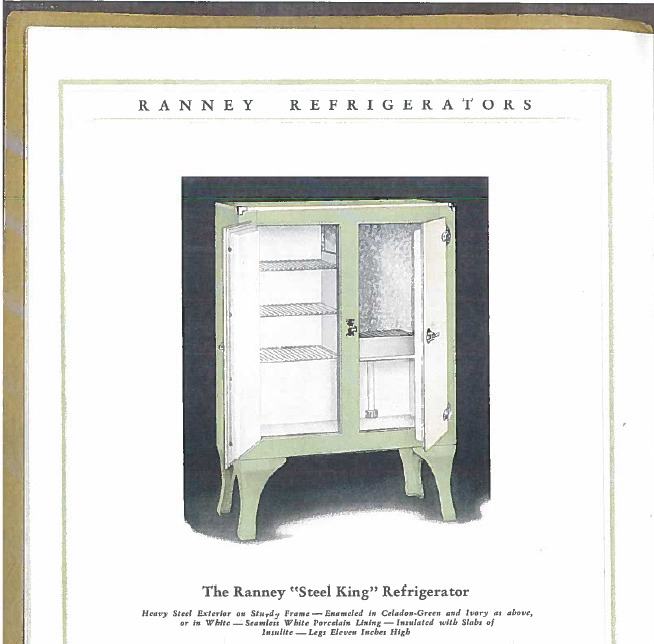
The largest is a cabinet with shelves. Adjacent to it, the remaining two compartments are stacked on top of each other. The medium one is to store the ice block, whereas the small cabinet below it houses the drainage system.
Ranney ice boxes were also purchased in bulk by the army during WW1 and WW2. Today, the Ranney refrigeration company is known as Marvel.
White Frost Refrigerators
Hugh L. was the president of the White Frost Refrigerator Company, Michigan. It began production early and acquired a patent in 1906. The company designed one of the first steel ice boxes.
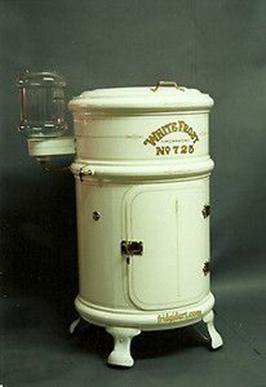
They had a unique cylindrical structure with an ice loading section on the top. Inside, there were 2 to 3 revolving shelves that were considered very high-tech. You can find many vintage White Frost Refrigerators today.
Check out this restored White Frost Ice Box (Coca Cola Version) currently listed on eBay!
Complete Antique Ice Box Value Guide
Antiques are precious, high-value goods in the present world. There are people out there who love collecting these rare finds and learning about their exciting histories. And so, like all other antiques, an old ice box is a much-wanted item too.
Below, we’ll walk you through the current value of an antique ice box. We’ll also explain to you the basics of determining values.
Are Antique Ice Boxes Worth Anything?
Yes, antique ice boxes are worth a lot!
While people used to buy ice boxes for up to $50 in the past, they hold a value between $500 to $10,000 today. The exact worth depends on the size, age, condition, and authenticity. Here’s a chart that will help you understand better!
Condition |
Price Range |
Popular Current Listings |
|
Refurbished Antique Ice Box |
Excellent |
$500 to $2000 |
|
Original Antique Ice Box |
Good |
$2000 to $5000 |
|
Rare Antique Ice Box |
Good to Average |
$10,000+ |
How to Determine the Value of an Old Ice Box?
Assessing the value of an old ice box is not an easy task. There are so many factors that come into play. So, if you’re interested in buying or selling an ice box, let’s discuss each factor in detail.
- Age
The oldest of antiques tends to be the most pricey. It’s because age is a clear indication of its originality. And, well, we find it quite amusing that something so old has survived this long.
It’s an artifact and a symbol of our past. We can find so much about our evolution from this ancient structure. So, who wouldn’t love paying thousands for something so rare and interesting?!
If you’re like us, you will simply be head over heels to find the oldest surviving ice box in your collection 😉
- Size
It’s true that the earliest ice boxes were small and compact. You could only store a few items at a time in it. However, later, commercial use ice boxes were introduced.
These huge ice boxes with glass front panels and intricate decor are more popular antiques today. You can expect their values to be more than $10,000. Take this Alaska Commercial Ice Box, for example.
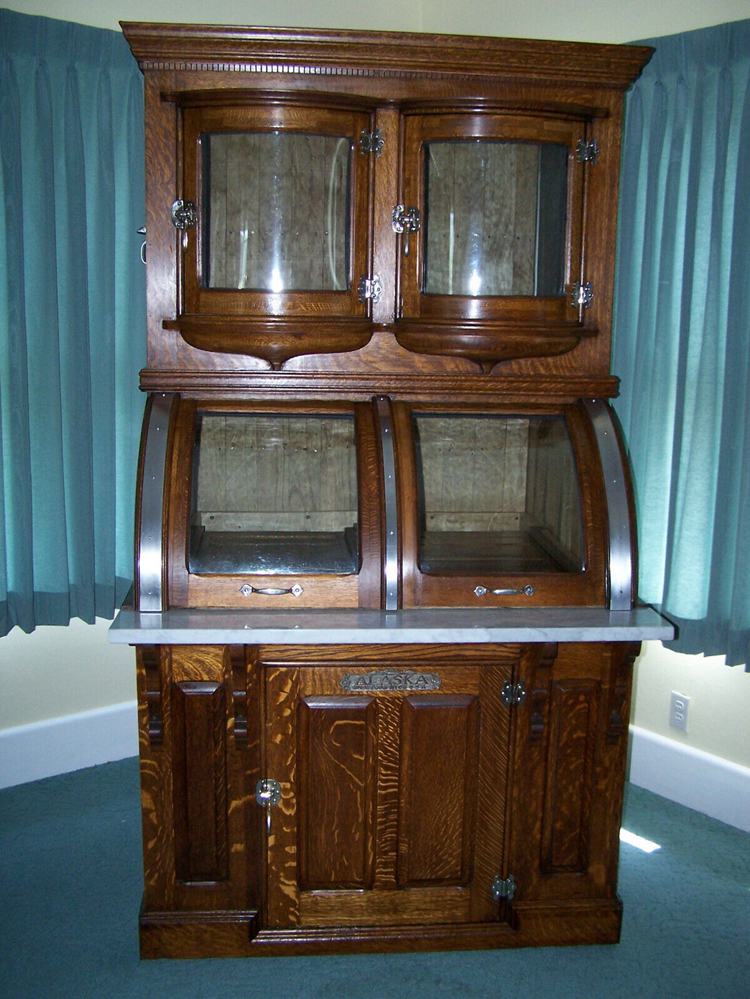
As you can see, this great piece has 4-compartments with curved glass doors. It has a faded and rusted company nameplate on the front. There’s also a large wooden cabinet below to probably store the ice blocks.
It is currently listed for $10,500 on eBay.
The price of an antique icebox reduces from this onwards. For example, the medium-sized antique ice box with porcelain finishings is listed for $3,100 on Etsy. Meanwhile, the 4-compartment McCray ice box from the 1900s is available for $2,750 on eBay.
- Condition
Completely rusted, damaged, and unusable ice boxes have no value. These antiques cannot be displayed or even examined. So, if you own or find something like this, know it’s pretty much useless.
On the other hand, ice boxes with little deterioration are extremely valuable. The well-preserved condition and original hardware make them a gem for collectors. You can expect their values to be above $2000.
However, if some parts of an antique wooden ice box have been replaced to maintain the condition, the value will drop significantly. An ice box with replaced or missing parts will have a price between $500 to $2000 or below.
Here are some examples currently listed on eBay:
- Originality & Reproductions
With antique collecting being so common, there’s no wonder that reproductions have swarmed into the market. People love to study their favorite antique ice boxes and create exact replicas.
There’s no harm in buying and selling these fake antiques as long as they’re sold for their rightful value. A reproduction should cost around $50. Even the finest ones sell for no more than $100.
If you’re afraid of frauds and scams, do take out some time and study the identification of an antique ice box. Watch this YouTube video to learn expert tips before you shop:
Frequently Asked Questions
How old are oak ice boxes?
The wooden ice boxes have been in use since the early 1800s. But, the classic wooden ice box that was designed especially for home came out in the 1830s. It was made from oak, walnut, pine, or ash.
So, an oak ice box from the 1830s would be around 200 years old by now. You need to date your antique ice box to find the age.
How much did the first ice box cost?
The ice boxes were considered an advanced technology back in time. These simple, non-mechanical appliances were sold at an average of $15 to $50. The price varied depending on size, design, and company.
Typically, a wooden ice box with a catch pan was cheaper than the one with a holding tank. It’s because the catch pan required regular changing while the latter did not.
What can I do with old ice chests?
There are plenty of uses for an antique wood ice box in today’s world too. You can store non-essential items in it. If it’s a genuinely valuable antique, display it in your home or take it to local antique shows.
Final Words
Summing it up, antique iceboxes are an excellent reminder of how life used to be simple. These non-mechanical and safe appliances can still function well in the present times. In fact, many antique enthusiasts love to fit these collectibles into their beautiful retro homes.
So, if you come across an antique ice box in your collection or wish to buy one, it’s important to know how to date it. It will tell you the accurate or estimated age of the ice box. As a result, you can buy or sell the ancient gem for the right value.
Here’s a recap of how to date an icebox:
- Look at the manufacturer mark
- Find distortion and decay
- Analyze the hardware
- Examine the material
- Go for the simplest designs
- Visit an antique professional
We hope this antique ice box guide has provided you with useful dating and value tips. In case you’ve any thoughts, do let us know in the comments below!





![Where To Sell Antique Furniture In 2022 [Ultimate Guide]](https://www.jacquelinestallone.com/wp-content/uploads/2022/09/Etsy-Your-Place-To-Buy-And-Sell-All-Things-Handmade-600x450.jpg)


